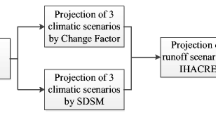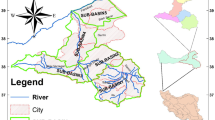Abstract
This study investigates the water availability scenario along Tokyo Metropolitan Area (TMA) under future climatic changes. TMA, which depends largely on the adjacent Tone river for its water supply, suffers from water shortage almost once in 2–3 yr. A methodology was developed considering integrated approach to ascertain probable impact of climatic changes on the overall water availability along the Tone river and its impact on TMA. Historical trend in hydro-climatic characteristics of the Tone River basin was investigated at the first place to assess the changes and interrelationships. A deterministic water balance model was later developed, integrating natural hydrological balance as well as several water uses and river regulation effects. The natural water balance part of the model was tested for some hypothetical climate change scenarios to observe the sensitivity of the Tone river flow to climatic perturbations. For the worst scenario of precipitation and temperature changes, the unregulated Tone river flow was observed to be reduced by around 20–50%, varying over different months. After considering river regulation effects from reservoirs and diversion, the regulated flow was further analyzed based on some risk indices. Drought risk was observed to be increased significantly for the periods between April–July.
Similar content being viewed by others
References
Aramaki, T. and Matsuo, T., 1998, ‘Evaluation model of policy scenarios for basin-wide water resources and quality management in the Tone river’, Water Sci. Techol. 38, 59–67.
Bobba, A. G., Jeffries, D. S., and Singh, V. P., 1999, ‘Sensitivity of hydrological variables in the Northeast Pond river watershed, Newfoundland, Canada, due to atmospheric change’, Water Resour. Manag. 13, 171–188.
Bronstert, A., Krol, M., Jaeger, A., and Gunter, A., 2002, Integrated modeling of climate, water, soil, agricultural and socio-economic processes: A general introduction of the methodology and some exemplary results from the semi-arid Northeast Brazil, Proceedings of the ICWRER 2002, Dresden, Germany, 377–381.
Bronstert, A., Jaeger, A., Gunter, A., Hauschild, M., Doll, P., and Krol, M., 2000, ‘Integrated modelling of water availability and water use in the semi-arid northeast of Brazil’, Phys. Chem. Earth (B) 25(3), 227–232.
FAO: 1996, CROPWAT A computer program for irrigation planning and management, FAO Irrigation and Drainage Paper 46, Rome, Italy.
Glecik, P. H., 1986, ‘Methods for evaluating the regional hydrologic impacts of global climatic changes’, J. Hydrol. 88, 97–116.
Glecik, P. H., 1987, ‘Regional hydrological consequences of increases in atmospheric CO2 and other trace Gases’, Clim. Change 10, 137–161.
GOJ (Government of Japan): 2002, Japan's Third National Communication Under the United Nations Framework Convention on Climate Change, 153–154.
Haith, D. A., Mandel, R., and Wu, R. S., 1996, Generalized Watershed Loading Functions (GWLF), Version 2.0 User's Manual, Department of Agricultural & Biological Engineering, Cornell University Riley-Robb Hall Ithaca NY U.S.A. 14853.
Hamon, W. R., 1961, ‘Estimating Potential Evapotranspiration’, J. Hydrol. Div. ASCE 87(3), 107–120.
Hashimoto, T., Stedinger, J. R., and Loucks, D. P., 1982, ‘Robustness of water resources systems’, Water Resour. Res. 18(1), 21–26.
Helsel, D. A. and Hirsch, R. M., 1992, Statistical Methods in Water Resources, Elsevier, New York, p. 522.
Hulme, M. and Sheard, N., 1999, Climate Change Scenarios for Japan, Climatic Research Unit, University of East Anglia, Norwich, UK.
IPCC, 2001, Third Assessment Report, Oxford University Press Ltd., U.K.
Kirshen, P. H. and Fennessey, N. M., 1995, ‘Possible climate change impacts on water supply of metropolitan Boston’, J. Water Resour. Plan. Manag. ASCE 121(1), 61–70.
Krol, M. S., Jaeger, A., Bronstert, A., and Krywkow, J., 2001, ‘The semi-arid integrated model (SIM), a regional integrated model assessing water availability, vulnerability of ecosystems and society in NE-Brazil’, Phys. Chem. Earth (B) 26(7–8), 529–533.
Lettenmaier, D. P. and Gan, T. Y., 1990, ‘Hydrologic sensitivity of the sacremento-San Joaquin River basin, California, to global warming’, Water Resour. Res. 26, 69–86.
McCabe, G. J. and Ayers, M. A., 1989, ‘Hydrologic effects of climate change in Delware River Basin’, Water Resour. Bull. 25(6), 1231–1241.
Maidment, D., 1993, Handbook of Hydrology, McGraw-Hill Publishers, U.S.A.
Masukura, K. and Yoshitani, J., 1992, Evaluation of Possible Precipitation Change over Japan and Discharge Variation in the Tone River, JUCHWR Publications no. 1, PWRI, Tsukuba, Japan, 221–232.
Mimikou, M., Kouvopoulos, Y., Cavadias, G., and Vayianos, N., 1991, ‘Regional Hydrological Effects of Climate Change’, J. Hydrol. 123, 119–146.
Nemec, J. and Schaake, J., 1982, ‘Sensitivity of water resources system to climatic variation’, Hydrol. Sci. J. 27, 327–343.
Nishioka, S. and Harasawa, H., 1998, Global Warming: The Potential Impact on Japan, Springler-Verlag, Tokyo.
Niwa, K., Hirose, M., and Takahiro, M., 1992, Assessment of the Global Warming Effect on Water resources in Japan, JUCHWR Publications no. 1, PWRI, Tsukuba, Japan, 265–273.
PWRI, 1997, Climate change impact on the water resources system in Japan. PWRI Research Report (in Japanese).
Schumann, A. and Antl, M., 2002, Uncertainties of climate change scenarios derived from general circulation models and implications for their use for hydrological impact assessments in water management, Proceedings of the ICWRER 2002, Dresden, Germany, 269–274.
Seki, M., 1992, River Administration system and Global Environmental Problems in Japan, Proceedings of the Workshop on the Effects of Global Climate Change on Hydrology and Water Resources at the Catchmrnt Scale, February 3–6, 1992, Tsukuba, Japan.
Suita, Y., Masuda, T., and Ichikawa, A., 1999, Estimation of Runoff from Rainfall and Water Quality Using ISIS and GIS, Proceedings of the 8th International Conference on Urban Storm Drainage, Sydney, Australia, 2169–2176.
Tung, C. and Haith, D., 1995, ‘Global-Warming Effects on the New York Streamflows’, J. Water Resour. Plan. Manage ASCE, 121(2), 216–225.
Vogel, R. M., Bell, C. J., and Fennessey, N. M., 1997, ‘Climate, stream flow and water supply in the northeastern United States’, J. Hydrol. 198, 42–68.
Xu, C. Y., 2000, ‘Modelling the effects of climate change on water resources in central Sweden’, Water Resour. Manag. 14, 177–189.
Yu, P., Yang, T., and Wu, C., 2002, ‘Impact of climate change on water resources in southern Taiwan’, J. Hydrol. 260, 161–175.
Author information
Authors and Affiliations
Corresponding author
Rights and permissions
About this article
Cite this article
Islam, M.S., Aramaki, T. & Hanaki, K. Development and Application of an Integrated Water Balance Model to Study the Sensitivity of the Tokyo Metropolitan Area Water Availability Scenario to Climatic Changes. Water Resour Manage 19, 423–445 (2005). https://doi.org/10.1007/s11269-005-3277-1
Received:
Accepted:
Issue Date:
DOI: https://doi.org/10.1007/s11269-005-3277-1




